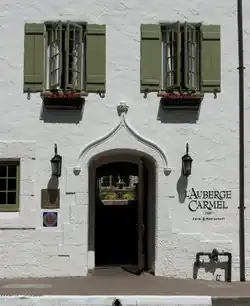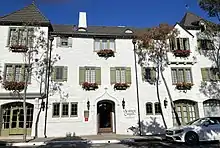Sundial Lodge
The Sundial Lodge, also known today as the L’Auberge Carmel, a Relais & Châteaux property, is a historic Medieval Revival hotel in Carmel-by-the-Sea, California. It was designed by architect Albert L. Farr of San Francisco Bay Area and was built in 1929–1930, by Master builder Michael J. Murphy. It was designated as an important commercial building in the city's Downtown Historic District Property Survey, and was recorded with the Department of Parks and Recreation on December 5, 2002.[1]
| Sundial Lodge | |
|---|---|
 Sundial Lodge, also known as the L’Auberge Carmel | |
| Location | Monte Verde Street and 7th Avenue., Carmel-by-the-Sea, California |
| Coordinates | 36°33′14″N 121°55′22″W |
| Built | 1929-1930 |
| Built by | Michael J. Murphy |
| Built for | Allen Knight |
| Original use | Apartments |
| Current use | Hotel |
| Architect | Albert L. Farr |
| Architectural style(s) | Medieval Revival |
| Website | L’Auberge Carmel |
 Sundial Lodge Location in the Monterey Peninsula | |
History

The Sundial Lodge is a three-story, wood framed Medieval Revival style hotel built around an interior courtyard. The exterior walls have smooth cement stucco. It has five interior stucco-clad chimneys. It is located on Monte Verde Street and 7th Avenue in Carmel-by-the-Sea, California. The building qualifies for inclusion in the Downtown Historic District Property Survey because it is an example one of the few remaining Medieval Revival designs from the early 1930s that has maintained its original appearance, and it is a good example of Medieval Revival design by San Francisco Bay Area architect Albert L. Farr. The concentration of Medieval Romanantic revival buildings in the area of Monte Verde Street, Ocean Avenue and Lincoln Avenue helped to define Carmel as a "European" village.[1]
The design of the lodge was inspired by Allen Knight's visit to eastern Europe in the late 1920s, where he enjoyed the old European charm of the hotels. He asked the owners of a Czech hotel in Prague to share their blueprints with him. It was these blueprints he gave to architect Albert L. Farr to use to design the Sundial apartments. He commissioned Farr to design the apartment building and Michael J. Murphy to do the construction on the property where his aunts had a home. Allen Knight's parents and his two aunts purchased three lots on Monte Verde Street 7th Avenue. On the property was a cottage that Knight's father had purchased and assembled from real estate developer James Franklin Devendorf. Knight had to move their home on the building site to a new location at Guadalupe Street and Sixth Avenue.[2][3] Knight got financial backing for the construction of the residential apartment building from friends Mary L. Hamlin and Alys Miller. Knight later served as the Carmel city councilman and mayor.[4]
The August 30, 1929, edition of the Carmel Pine Cone stated:
The big steam shovel has begun its opening part in the building of the Sundial Court Apartments on the east side of Monte Verde Street between Ocean Avenue and Seventh. Soon will rise a structure new in Carmel’s experience, to mark an era of the town’s growth. The building will house thirteen small apartments, three rooms each, and eight one-room-with-bath accommodations for bachelors, male or female. The Sundial Court to be built around a court, will be three stories high on its western side, facing the sea, two stories high the balance of the structure The architecture is European, probably more Bohemian than of any other national type, and fits in well with Carmel’s general scheme.”[5]
In December 1929, the Carmel Pine Cone announced the newly started hotel, that "A block below, Monte Verde Street has gained by the newly started Sundial Court apartments, between Seventh and Eighth. The architecture is European, probably more Bohemian than of any other national type, and fits in well with Carmel's general scheme."[6]
On May 23, 1930, M. J. Murphy, Inc., completed the contract for the Sundial Court Apartments. The hotel officially opened in June 1930, with an announcement in the Carmel Pine Cone saying: "Sundial Court Apartments ready June first on Monte Verde south of Ocean. Mrs. Mary L. Hamlin Manager".[7][3] Originally, the lobby had two spaces for shops on the first floor, and the second floor housed three rooms apartments with a living area, a disappearing closet-bed, kitchenette and bath. The third floor has an extra room with a bath, which could be rented separately or used to make existing apartments larger. In 1992, the Sundial Court Apartments became the Sundial Lodge turning the 21 apartments into 19 guestrooms decorated with a French country motif and was featured in the Architectural and History Survey of Carmel-by-the-Sea Historic Inns. The Sundial Court Apartments was the first apartment building in Carmel.[8][2]
In 1951, Canadian born artist Henrietta Shore's studio was at the Sundial Lodge.[9] She once gave Knight a painting as her rent payment. In the early 1950's, Ernest K. Gann wrote Soldier of Fortune in a room at the Sundial Lodge, and his typist used the large dressing room as a sleeping room.[10]
In 2003, the Sundial Lodge was sold for an undisclosed price to the Mirabel Hotel and Restaurant Group.[2] CEO David Fink, changed the name to L'Auberge Carmel. In 2004, the Mirabel Hotel and Restaurant Group re-opened the hotel, after a two-year closer to bring it back to its 1929 appearance. The hotel was restored, reconfiguring all 20 guest rooms, the entrance and landscaping. A million dollar remodel was done in 2012 that included extensive upgrades to all guest-rooms, lobby, courtyard, and the Aubergine restaurant.[11][12]
See also
References
- Kent L. Seavey (December 5, 2002). "Department Of Parks And Recreation" (PDF). National Park Service. Retrieved April 8, 2022.
- "Allen Knight And The History Of L'Auberge Carmel". carmelbytheseaca.blogspot.com. Retrieved April 9, 2022.
- Seavey, Kent (2007). Carmel, A History in Architecture. pp. 93–94. ISBN 9780738547053. Retrieved 2022-04-09.
{{cite book}}:|work=ignored (help)CS1 maint: location missing publisher (link) - "Sundial Court To Open Soon". Carmel Pine Cone. Carmel-by-the-Sea, California. May 23, 1930. Retrieved April 8, 2022.
- "Work Has Begun On Sundial Court Apartments". Carmel Pine Cone. Carmel-by-the-Sea, California. August 30, 1929. Retrieved April 8, 2022.
- "Artistry In Construction Marks Carmel's Growth". Carmel Pine Cone. Carmel-by-the-Sea, California. December 12, 1929. Retrieved April 8, 2022.
- "Sundial Court Apartments". Carmel Pine Cone. Carmel-by-the-Sea, California. May 16, 1930. Retrieved April 8, 2022.
- "Historic Walking Tour". www.carmelcalifornia.com. Carmel-by-the-Sea, California. Retrieved 2022-03-30.
- "Henrietta Shore". The Ottawa Citizen (17 Feb 1951, Sat): 11. 1951. Retrieved 21 January 2020.
- "Historic Inns Carmel-by-the-Sea" (PDF). Carmel Historical Survey. Carmel-by-the-Sea, California. Apr 1992. Retrieved 2022-05-14.
- "About us". Carmel-by-the-Sea, California. Retrieved 2022-04-09.
- Elaine Hesser (30 Nov 2012). "Carmel's L'Auberge gets a cosmetic make-over". The Californian. Carmel-by-the-Sea, California. p. C10. Retrieved 2022-04-08.